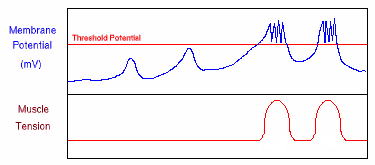VIVO Pathophysiology
Electrophysiology of Gastrointestinal Smooth Muscle
Normal gastrointestinal motility results from coordinated contractions of smooth muscle, which in turn derive from two basic patterns of electrical activity across the membranes of smooth muscle cells - slow waves and spike potentials.
Like other excitable cells, gastrointestinal smooth muscle cells maintain a electrical potential difference across their membranes. The resting membrane potential of smooth muscle cells is between -50 and -60 mV. In contrast to nerves and other types of muscle cells, the membrane potential of smooth muscle cells fluctuates spontaneously.
Because the cells are electrically coupled, these fluctuations in membrane potential spread to adjacent sections of muscle, resulting in what are called "slow waves" - waves of partial depolarization in smooth muscle that sweep along the digestive tube for long distances. These partial depolarizations are equivalent to fluctuations in membrane potential of 5 to 15 mV.
The frequency of slow waves depends on the section of the digestive tube - in the small intestine, they occur 10 to 20 times per minute and in the stomach and large intestine 3 to 8 times per minute. Slow wave activity appears to be a property intrinsic to smooth muscle and not dependent on nervous stimuli.
Importantly, slow waves are not action potentials and by themselves do not elicit contractions. Rather, they coordinate or synchronize muscle contractions in the gut by controlling the appearance of a second type of depolarization event - "spike potentials" - which occur only at the crests of slow waves.
Spike potentials are true action potentials that elicit muscle contraction. They result when a slow wave passes over an area of smooth muscle that has been primed by exposure to neurotransmitters released in their vicinity by neurons of the enteric nervous system. The neurotransmitters are released in response to a variety of local stimuli, including distension of the wall of the digestive tube and serve to "sensitize" the muscle by making its resting membrane potential more positive.

One can now step back and understand how a particular pattern of motility is achieved. Think for a moment about what happens when a large bolus of ingested food enters the small intestine:
- The bolus distends the gut, stretching its walls.
- Stretching stimulates nerves in the wall of the gut to release neurotransmitters into smooth muscle at the site of distension - the membrane potential of that section of muscle becomes "more depolarized."
- When a slow wave passes over this area of sensitized smooth muscle, spike potentials form and contraction results.
- The contraction moves around and along the gut in the coordinated manner because the muscle cells are electrically coupled through gap junctions.
Send comments to Richard.Bowen@colostate.edu
